

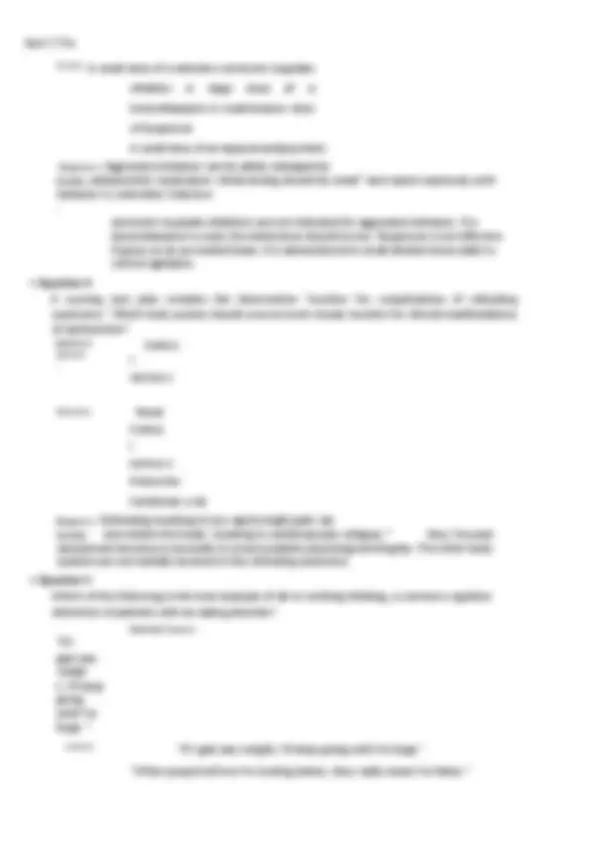
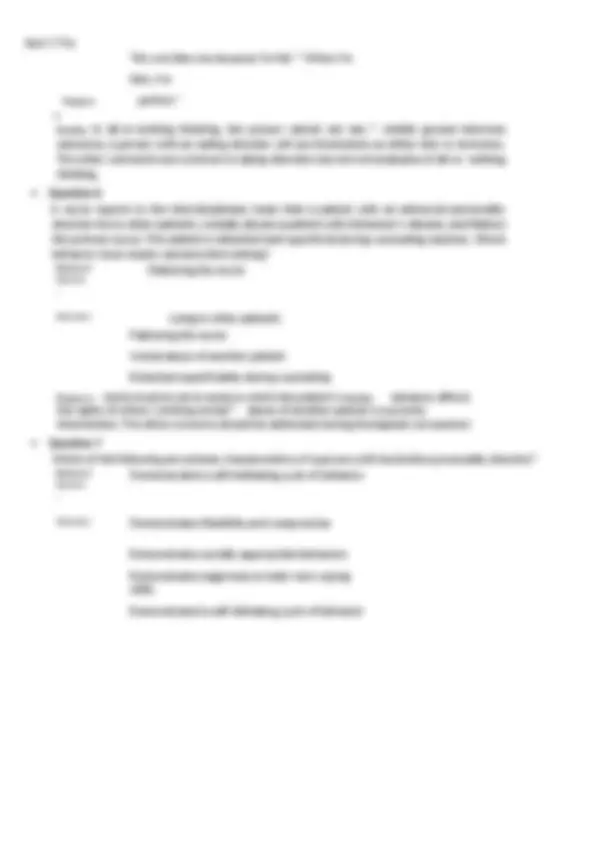
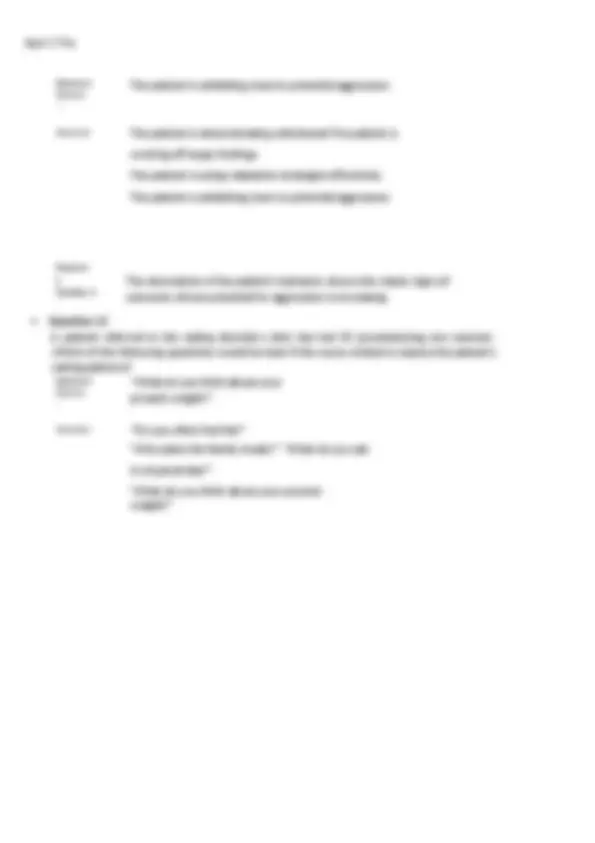
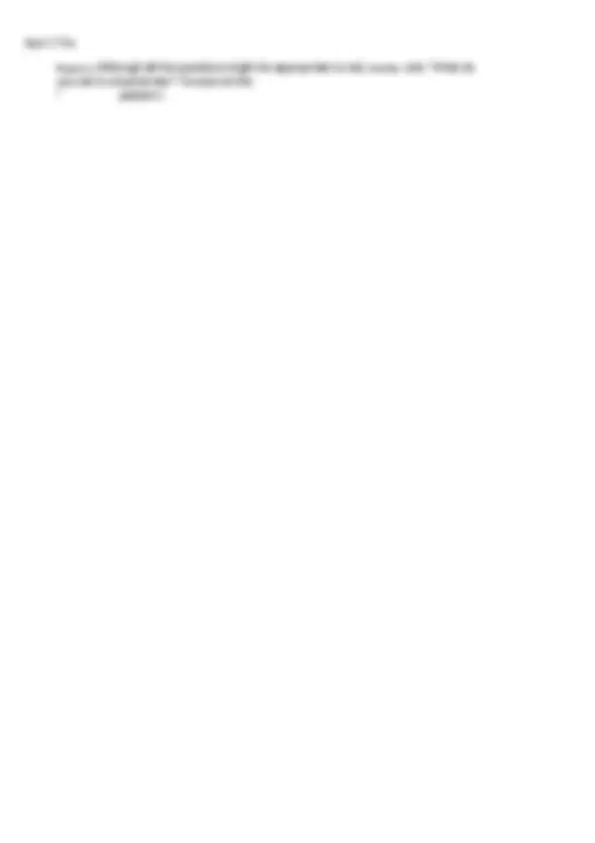
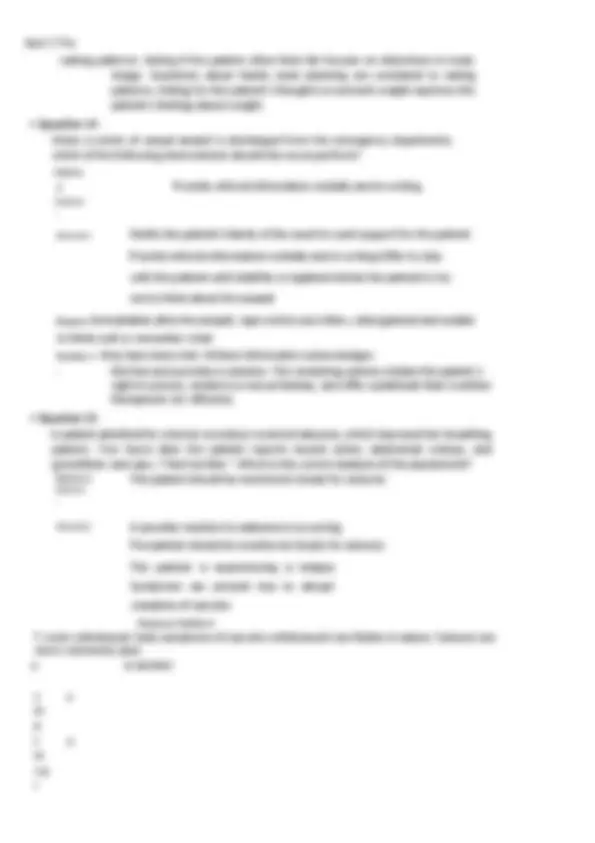
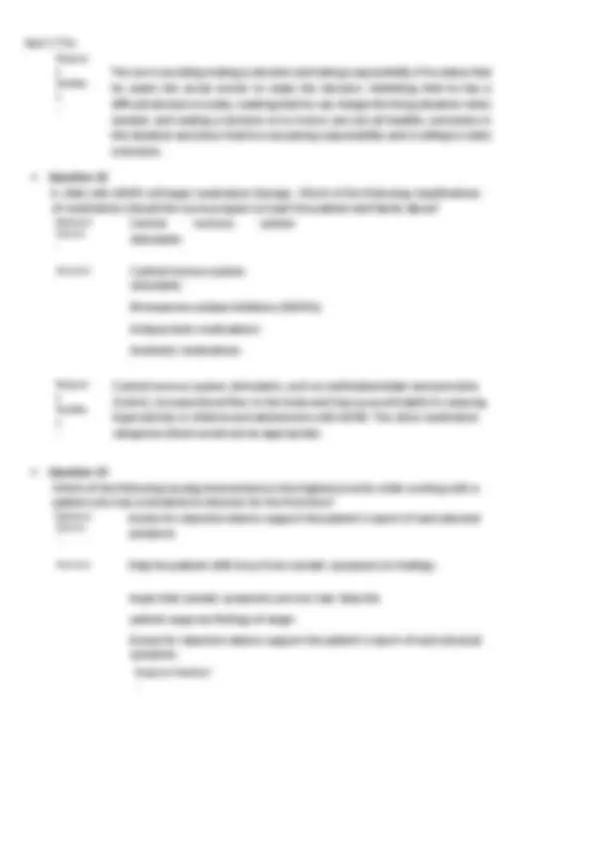
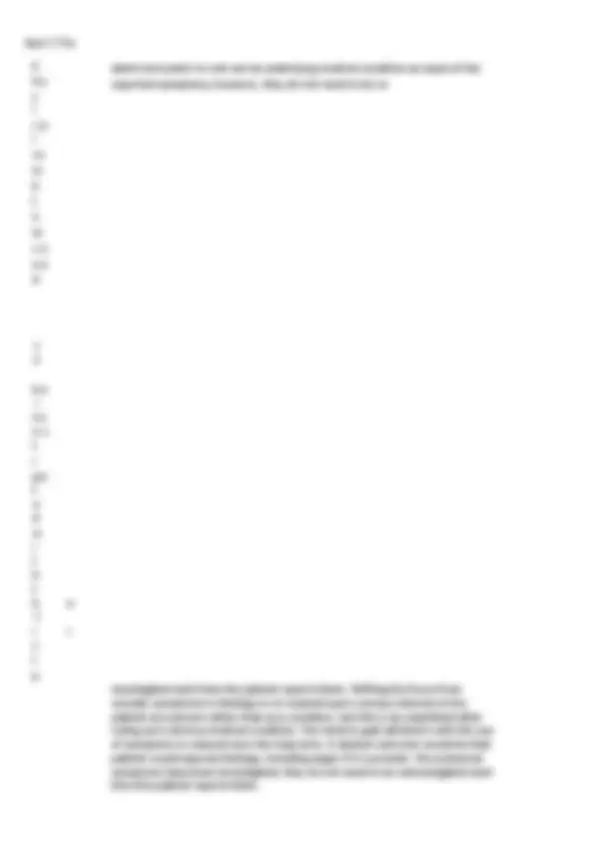
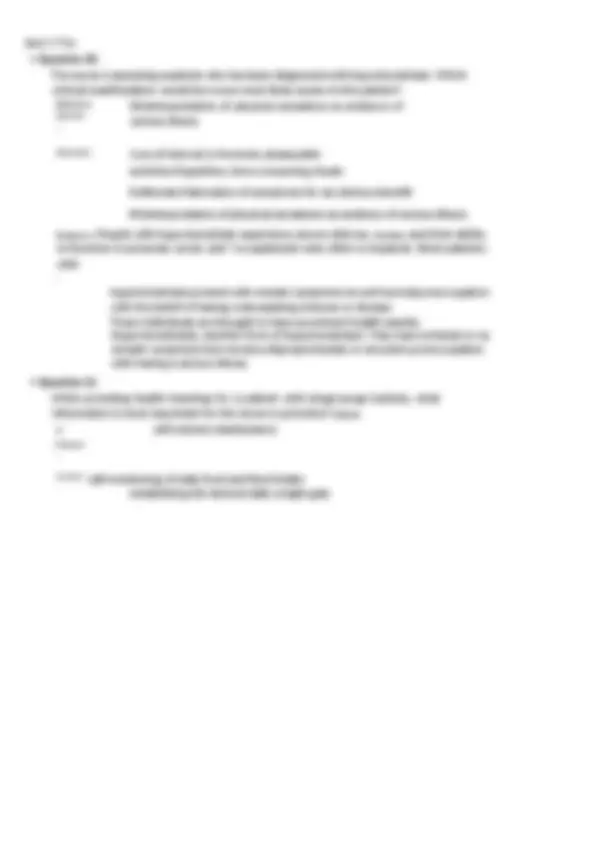
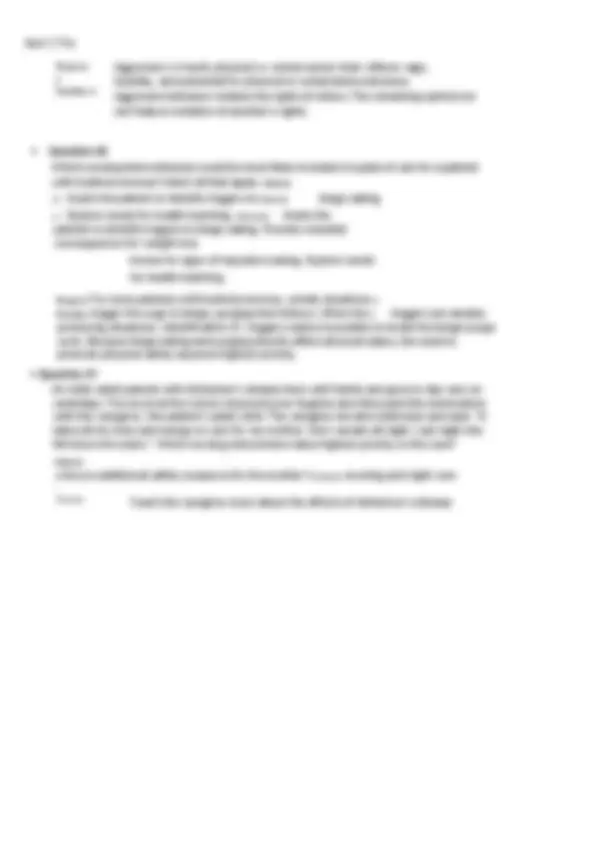
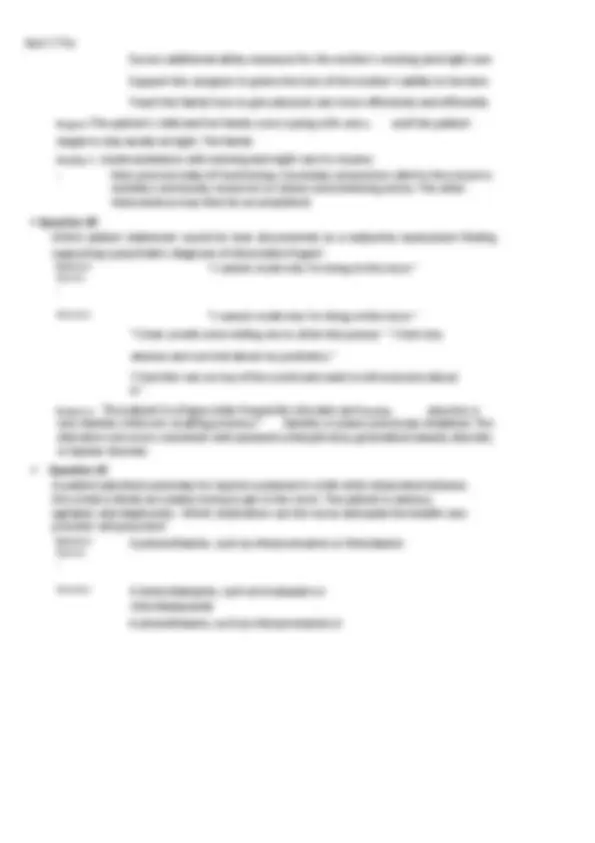
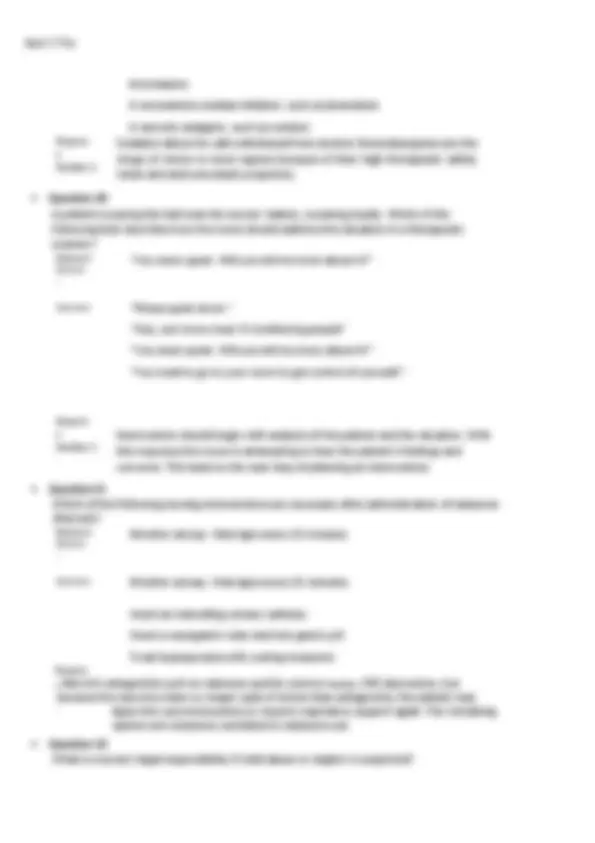
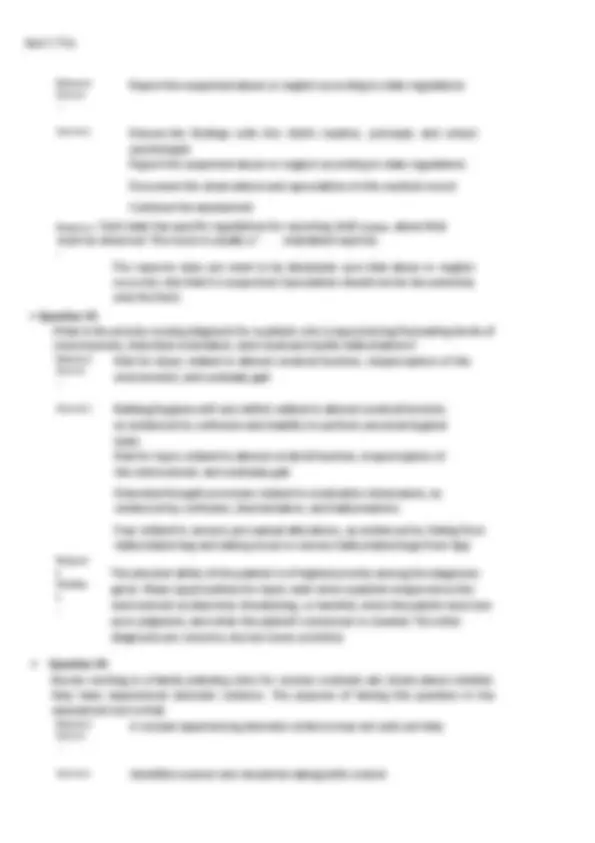
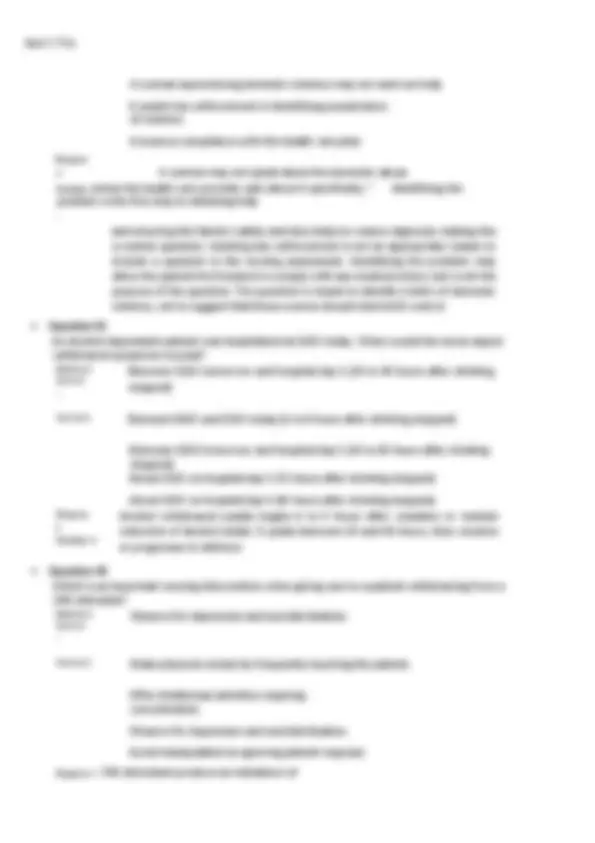
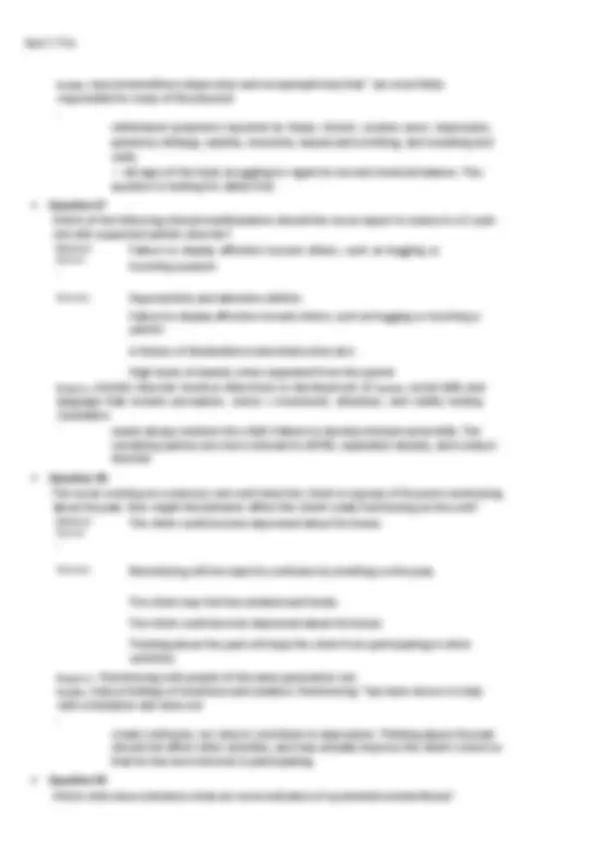
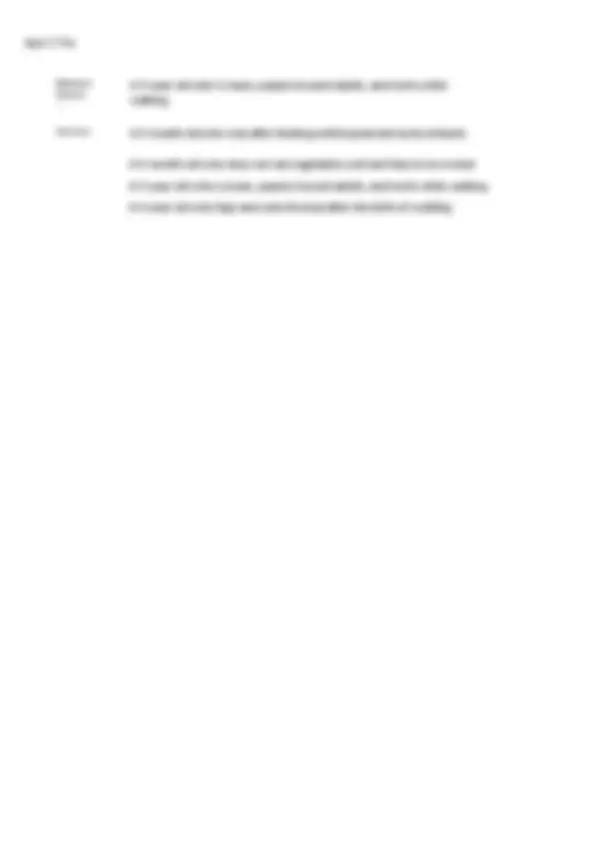
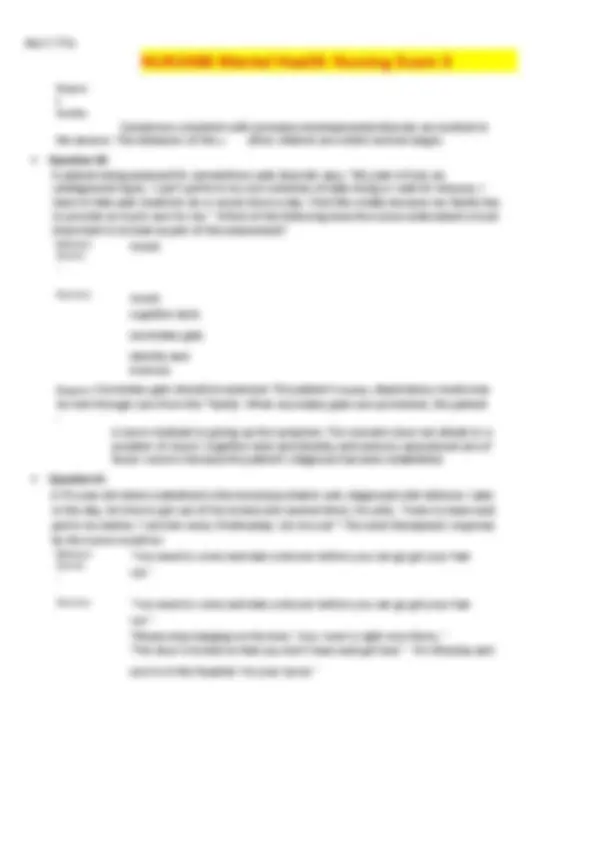
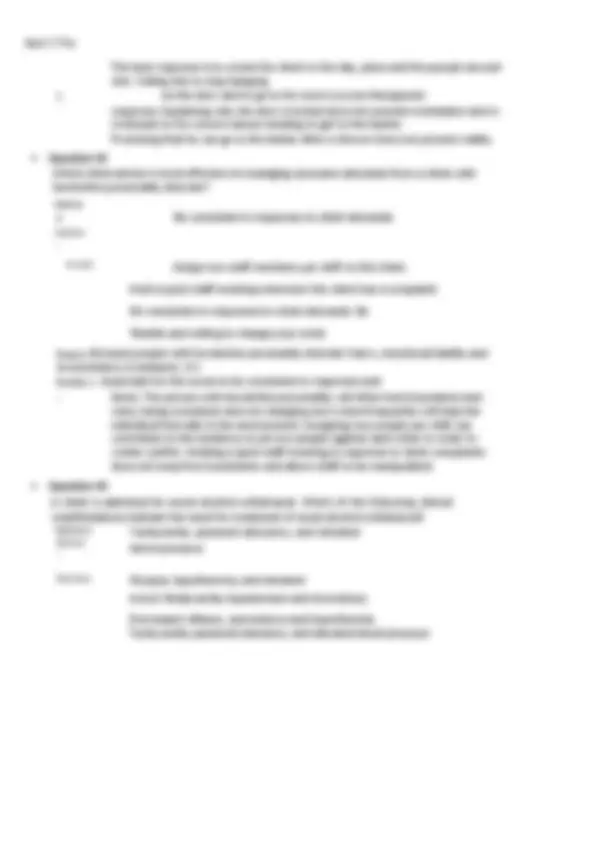
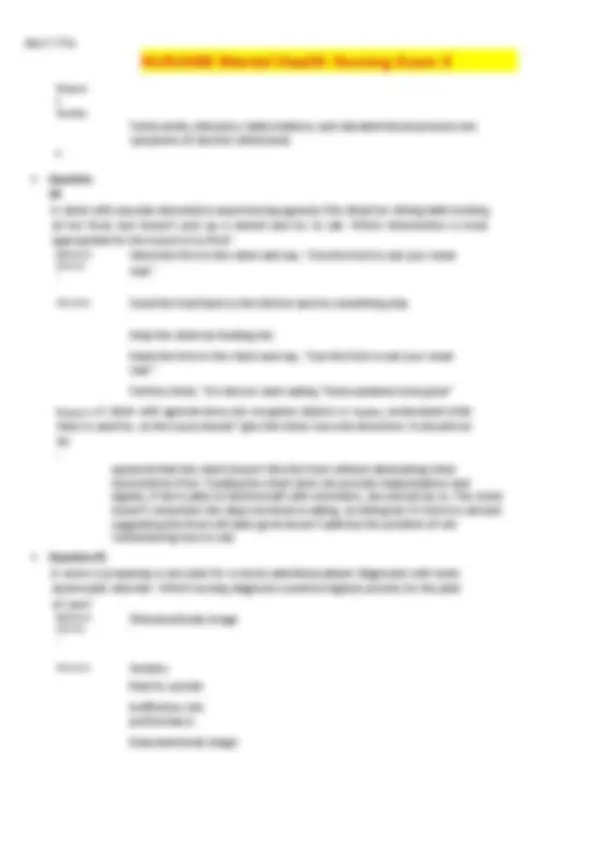
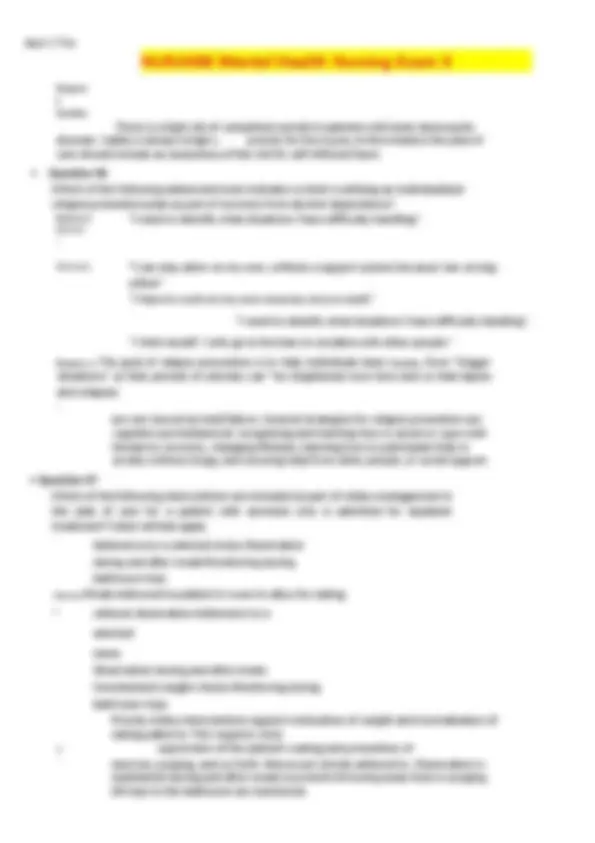
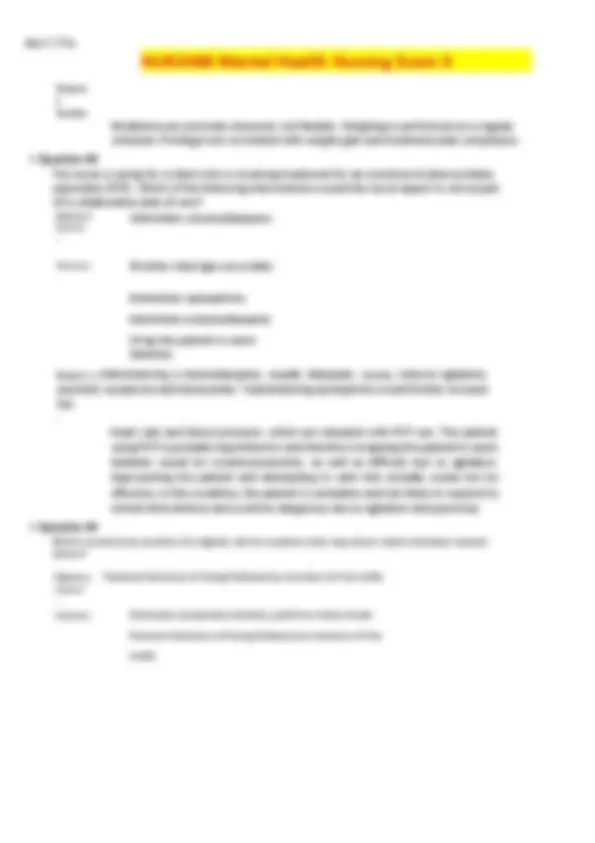
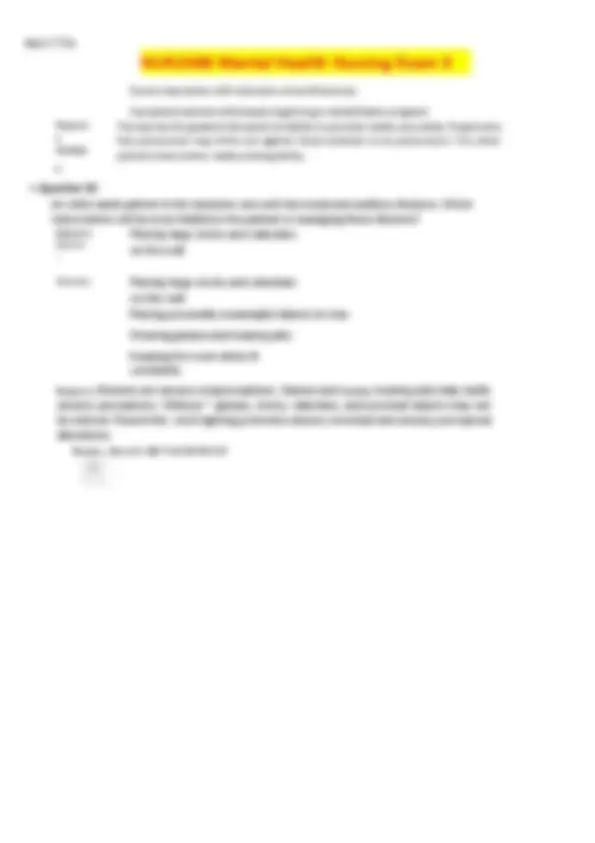


Study with the several resources on Docsity

Earn points by helping other students or get them with a premium plan


Prepare for your exams
Study with the several resources on Docsity

Earn points to download
Earn points by helping other students or get them with a premium plan
Community
Ask the community for help and clear up your study doubts
Discover the best universities in your country according to Docsity users
Free resources
Download our free guides on studying techniques, anxiety management strategies, and thesis advice from Docsity tutors
A set of questions and answers related to a mental health nursing exam. The questions cover a wide range of topics in mental health nursing, including substance abuse, personality disorders, eating disorders, abuse and neglect, and psychiatric symptoms. The answers provide detailed explanations and feedback on the correct responses. This document could be useful for university students studying mental health nursing, as it provides practice questions and explanations that could help them prepare for exams or assessments in this field. The level of detail and the range of topics covered suggest that this document is likely intended for use in a university-level mental health nursing course, potentially at the undergraduate or graduate level.
Typology: Exams
1 / 30

This page cannot be seen from the preview
Don't miss anything!























- Question 1 A patient with a history of cocaine use reports a concurrent history of using other drugs in order to counteract the effects of cocaine. Which drug is this patient likely to have abused? Selecte d Answer : Alcohol Answers: (^) PCP Alcoh ol Methylphen i date Caffeine Respons e Alcohol is a depressant which can neutralize the effects of Feedbac cocaine, which is a stimulant. Caffeine, methylphenidate k:^ (used to treat ADHD) and the illegal drug PCP are also stimulating and would only exacerbate the effects of cocaine. - Question 2 A patient is admitted with a heart rate of 53 bpm, respirations 6/min, temp 96.8 and pinpoint pupils. Based on these clinical manifestations, what substance did this patient most likely overdose on? Selecte d Answer : Marijuana Answers: (^) Opioids Alcohol Marijuan a Amphetam ine Respons e Opioids include prescribed medications such as Feedbac oxycodone and morphine, and the illegal substance k:^ heroin. The above symptoms are typical of opioid overdose, but are not typically seen with marijuana, alcohol or amphetamines. - Question 3 An elderly client with cognitive impairment is combative and pulled out a nasogastric tube, intravenous line, and indwelling urinary catheter. What can the nurse anticipate that the health care provider will most likely prescribe?
Answers: (^) A small dose of a selective serotonin reuptake inhibitor A large dose of a benzodiazepine A maintenance dose of buspirone A small dose of an atypical antipsychotic Respons e Aggressive behavior can be safely managed by Feedbac antipsychotic medication. Initial dosing should be small k^ and raised cautiously until behavior is controlled. Selective :
- Question 4 serotonin reuptake inhibitors are not indicated for aggressive behavior. If a benzodiazepine is used, the initial dose should be low. Buspirone is not effective if given on an as-needed basis. It is administered in small divided doses daily to control agitation. A nursing care plan contains the intervention “monitor for complications of refeeding syndrome.” Which body system should a nurse most closely monitor for clinical manifestations of dysfunction? Selecte d Answer : Centra l nervou s Answers: (^) Renal Centra l nervou s Endocrine Cardiovasc u lar Respons e Refeeding resulting in too-rapid weight gain can Feedbac overwhelm the heart, resulting in cardiovascular collapse; k:^ thus focused assessment becomes a necessity to ensure patient physiological integrity. The other body systems are not initially involved in the refeeding syndrome. - Question 5 Which of the following is the best example of all-or-nothing thinking, a common cognitive distortion of patients with an eating disorder? Selected Answer: “If I gain any weigh t, I’ll keep going until I’m huge. ” Answers: (^) “If I gain any weight, I’ll keep going until I’m huge.” “When people tell me I’m looking better, they really mean I’m fatter.”
“No one likes me because I’m fat.” “When I’m thin, I’m Respons perfect.” e Feedbac In all-or-nothing thinking, the person cannot see any k:^ middle ground between extremes; a person with an eating disorder will see themselves as either thin or immense. The other comments are common in eating disorders but are not examples of all-or- nothing thinking.
- Question 6 A nurse reports to the interdisciplinary team that a patient with an antisocial personality disorder lies to other patients, verbally abuses a patient with Alzheimer’s disease, and flatters the primary nurse. This patient is detached and superficial during counseling sessions. Which behavior most clearly warrants limit setting? Selecte d Answer : Flattering the nurse Answers: (^) Lying to other patients Flattering the nurse Verbal abuse of another patient Detached superficiality during counseling Respons e Limits must be set in areas in which the patient’s Feedbac behavior affects the rights of others. Limiting verbal k:^ abuse of another patient is a priority intervention. The other concerns should be addressed during therapeutic encounters. - Question 7 Which of the following are primary characteristics of a person with borderline personality disorder? Selecte d Answer : Demonstrated a self-defeating cycle of behavior Answers: (^) Demonstrates flexibility and compromise Demonstrates socially appropriate behaviors Demonstrates eagerness to learn new coping skills Demonstrated a self-defeating cycle of behavior
A patient is admitted for psychiatric observation after being arrested for breaking windows in the home of a former girlfriend who had refused to see him. His history reveals childhood abuse by a punitive father, torturing family pets, and an arrest for disorderly conduct. Which nursing diagnosis has priority in the plan of care? Selecte d Answer : Post-trauma syndrome Answers: (^) Risk for injury Post-trauma syndrome Disturbed thought processes Risk for otherdirected violence Respons e The defining characteristics for Risk for other-directed Feedbac violence include a history of being abused as a child, k:^ having committed other violent acts, and demonstrating poor impulse control. The defining characteristics for the other diagnoses are not present in the scenario
- Question 11 A patient is referred to the mental health center by the family health care provider. Over the past year, the patient has cooked gourmet meals for family members, but eats only tiny portions of the food. The patient wears layers of loose clothing, saying, “It’s just my style.” The patient’s weight has dropped from 130 to 95 pounds. The patient has amenorrhea. Which medical diagnosis are the history and symptoms are most consistent with? Selecte d Answer : Anorexia nervosa Answers: (^) Anorexia nervosa Bulimia nervosa Binge eating Eating disorder not otherwise specified Respons e Feedbac k : Overly controlled eating behaviors, extreme weight loss, amenorrhea, preoccupation with food, and wearing several layers of loose clothing to appear larger are part of the clinical picture of an individual with anorexia nervosa. The individual with bulimia usually is near normal weight. The binge eater is often overweight. The patient with eating disorder not otherwise specified may be obese. - Question 12 A patient sat in silence for 20 minutes after a therapy appointment. The patient appeared tense and vigilant. The patient abruptly stood up and paced back and forth across the day room, clenching and unclenching his fists. Next, he stopped and stared intently into the face of a psychiatric technician. Which of the following best explains the nurse’s observations of this patient?
Selecte d Answer : The patient is exhibiting clues to potential aggression. Answers: Respons e Feedbac k: The patient is demonstrating withdrawal The patient is working off angry feelings. The patient is using relaxation strategies effectively. The patient is exhibiting clues to potential aggression. The description of the patient’s behavior shows the classic signs of someone whose potential for aggression is increasing.
- Question 13 A patient referred to the eating disorders clinic has lost 35 poundsduring one summer. Which of the following questions would be best if the nurse wished to assess the patient’s eating patterns? Selecte d Answer : “What do you think about your present weight?” Answers: (^) “Do you often feel fat?” “Who plans the family meals?” “What do you eat in a typical day?” “What do you think about your present weight?”
: eating patterns. Asking if the patient often feels fat focuses on distortions in body image. Questions about family meal planning are unrelated to eating patterns. Asking for the patient’s thoughts on present weight explores the patient’s feelings about weight.
- Question 14 When a victim of sexual assault is discharged from the emergency department, which of the following interventions should the nurse perform? Selecte d Provide referral information verbally and in writing Answer : Answers: Notify the patient’s family of the event to seek support for the patient Provide referral information verbally and in writing Offer to stay with the patient until stability is regained Advise the patient to try not to think about the assault Respons Immediately after the assault, rape victims are often e disorganized and unable to think well or remember what Feedbac k they have been told. Written information acknowledges : this fact and provides a solution. The remaining options violate the patient’s right to privacy, evidence a rescue fantasy, and offer a platitude that is neither therapeutic nor effective. - Question 15 A patient admitted for a heroin overdose received naloxone, which improved her breathing pattern. Two hours later the patient reports muscle aches, abdominal cramps, and gooseflesh, and says, “I feel terrible.” Which is the correct analysis of this assessment? Selecte d Answer : The patient should be monitored closely for seizures Answers: (^) A peculiar reaction to naloxone is occurring The patient should be monitored closely for seizures The patient is experiencing a relapse Symptoms are present due to abrupt cessation of narcotic Response Feedback: T rcotic withdrawal. Early symptoms of narcotic withdrawal h are flulike in nature. Seizures are more commonly seen e in alcohol s y m p t o m s g i
v e n i n t h e q u e s t i o n a r e c o n s i s t e n t w i t h n a wit hd ra wa l sy nd ro me .
- Question 16 A health care provider writes these new prescriptions for a nursing home resident: 2-g sodium diet; restraints as needed for behavioral problems; limit fluids to 2000 mL daily; continue antihypertensive medication; milk of magnesia 30 mL orally one time as needed if no bowel movement for 3 days. Which of the following is most appropriate for the nurse to do first? Selecte d Answer : Clarify the order for restraints Answers: (^) Clarify the order for fluid restriction
Respons e Feedbac k : The son is avoiding making a decision and taking responsibility if he states that he wants the social worker to make the decision. Admitting that he has a difficult decision to make, realizing that he can change the living situation when needed, and making a decision to try home care are all healthy comments in this situation and show that he is accepting responsibility and is willing to make a decision.
- Question 18 A child with ADHD will begin medication therapy. Which of the following classifications of medications should the nurse prepare to teach the patient and family about? Selecte d Answer : Central nervous system stimulants Answers: (^) Central nervous system stimulants Monoamine oxidase inhibitors (MAOIs) Antipsychotic medications Anxiolytic medications Respons e Feedbac k : Central nervous system stimulants, such as methylphenidate and pemoline (Cylert), increase blood flow to the brain and have proved helpful in reducing hyperactivity in children and adolescents with ADHD. The other medication categories listed would not be appropriate - Question 19 Which of the following nursing interventions is the highest priority while working with a patient who has a somatoform disorder for the first time? Selecte d Answer : Assess for objective data to support the patient’s report of each physical symptom. Answers: (^) Help the patient shift focus from somatic symptoms to feelings. Imply that somatic symptoms are not real. Help the patient suppress feelings of anger. Assess for objective data to support the patient’s report of each physical symptom. Response Feedback :
P (^) atient encounter to rule out an underlying medical condition as cause of the h y (^) reported symptoms; however, they do not need to be re- s i c a l s y m p t o m s n e e d t o b e i n v e s t i g a t e d w i t h t h e f i r s t p investigated each time the patient reports them. Shifting the focus from somatic symptoms to feelings or to neutral topics conveys interest in the patient as a person rather than as a condition, but this is accomplished after ruling out a serious medical condition. The need to gain attention with the use of symptoms is reduced over the long term. A desired outcome would be that patient would express feelings, including anger if it is present. Once physical symptoms have been investigated, they do not need to be reinvestigated each time the patient reports them.
symptoms of hypokalemia self- Respons esteem maintenance e Feedbac Hypokalemia results from potassium loss associated with k^ vomiting. Physiological integrity can be maintained if the :
- Question 22 patient can self-diagnose potassium deficiency and adjust the diet or seek medical assistance. Self-monitoring of daily food and fluid intake is not useful if the patient purges. Daily weight gain may not be desirable for a patient with bulimia nervosa. Self-esteem is an identifiable problem but is of lesser priority than the risk for hypokalemia. An 11 - year-old is absent from school to stay at home and care for siblings while the parents work. The family cannot afford a babysitter. When asked about the parents, the child reluctantly says, “I don’t think my parents like me very much. They call me stupid and say I never do anything right.” Which type of abuse is most likely? Selecte d Answer : Emotion al Answers: Respons e Feedbac k: - Question 23 Physical Sexual Emotion al Econo m ic Examples of emotional abuse include having an adult demean a child’s worth or frequently criticize or belittle the child. No data support physical battering or endangerment, sexual abuse, or economic abuse. The student nurse is asked to provide a general and concise description of persons with personality disorders. Which of the following would be the best description? Selecte d Answer : “They have difficulties in social, family and work relationships.” Answers: (^) “They can tolerate high levels of stress.” “They have difficulties in social, family and work relationships.” “They are good at compromise and often function
as mediators.” “They often seek instructions to learn better coping behaviors.” Respons The defining characteristic of personality disorders is
e Feedbac k : difficulty in social relationships. Most people with personality disorders do not respond well to stress and are generally inflexible and poor compromisers. People with personality disorders tend not to seek help on their own due to a variety of factors; for example, their adaptations make them feel that they are functioning well, they have little desire to change, and possess an overall distrust of others.
- Question 24 A nurse in the emergency department tells the daughter of an older adult woman, “Your mother had a severe stroke.” The daughter tearfully says, “Who will take care of me now? My mother always tells me what to do, what to wear, and what to eat. I need someone to reassure me when I get anxious.” This behavior could best be assessed as: Selecte d Answer : Depend e nt. Answers: Respons e Feedbac k: - Question 25 Histrionic . Depend e nt. Narcissis t ic. Borderlin e. Clients with a dependent personality have an inability to complete anything on their own; they are unable to make decisions without excessive advice and reassurance as described by the client above. Which behavior best describes physical aggression? Selecte d Answer : Stomping away from the nurses’ station, going to the day room, and grabbing a pool cue from a patient standing at the pool table Answers: (^) Stomping away from the nurses’ station, going to the day room, and grabbing a pool cue from a patient standing at the pool table Bursting into tears, leaving the community meeting, and sitting on a bed hugging a pillow and sobbing Telling the primary nurse, “When you told me that I could not have a second helping at lunch, I felt angry.” Telling the medication nurse, “I am not going to take that, or any other, medication.”
Secure additional safety measures for the mother’s evening and night care Support the caregiver to grieve the loss of the mother’s ability to function Teach the family how to give physical care more effectively and efficiently Respons The patient’s child and her family were coping with care e until the patient began to stay awake at night. The family Feedbac k needs assistance with evening and night care to resume : their precrisis state of functioning. Secondary prevention calls for the nurse to mobilize community resources to relieve overwhelming stress. The other interventions may then be accomplished.
- Question 28 Which patient statement would be best documented as a subjective assessment finding supporting a psychiatric diagnosis of dissociative fugue? Selecte d Answer : “I cannot recall why I’m living in this town.” Answers: (^) “I cannot recall why I’m living in this town.” “I hear a male voice telling me to drink this poison.” “I feel very anxious and worried about my problems.” “I feel like I am on top of the world and want to tell everyone about it.” Respons e The patient in a fugue state frequently relocates and Feedbac assumes a new identity while not recalling previous k:^ identity or places previously inhabited. The distracters are more consistent with paranoid schizophrenia, generalized anxiety disorder, or bipolar disorder. - Question 29 A patient admitted yesterday for injuries sustained in a fall while intoxicated believes the window blinds are snakes trying to get in the room. The patient is anxious, agitated, and diaphoretic. Which medication can the nurse anticipate the health care provider will prescribe? Selecte d Answer : A phenothiazine, such as chlorpromazine or thioridazine Answers: (^) A benzodiazepine, such as lorazepam or chlordiazepoxide A phenothiazine, such as chlorpromazine or
Respons e Feedbac k: thioridazine A monoamine oxidase inhibitor, such as phenelzine A narcotic analgesic, such as codeine Sedation allows for safe withdrawal from alcohol. Benzodiazepines are the drugs of choice in most regions because of their high therapeutic safety index and anticonvulsant properties.
- Question 30 A patient is pacing the hall near the nurses’ station, swearing loudly. Which of the following best describes how the nurse should address this situation in a therapeutic manner? Selecte d Answer : “You seem upset. Will you tell me more about it?” Answers: Respons e Feedbac k: - Question 31 “Please quiet down.” “Hey, you’re too loud. It’s bothering people” “You seem upset. Will you tell me more about it?” “You need to go to your room to get control of yourself.” Intervention should begin with analysis of the patient and the situation. With this response the nurse is attempting to hear the patient’s feelings and concerns. This leads to the next step of planning an intervention. Which of the following nursing interventions are necessary after administration of naloxone (Narcan)? Selecte d Answer : Monitor airway. Vital signs every 15 minutes. Answers: (^) Monitor airway. Vital signs every 15 minutes. Respons Insert an indwelling urinary catheter. Insert a nasogastric tube and test gastric pH. Treat hyperpyrexia with cooling measures e Narcotic antagonists such as naloxone quickly reverse^ Feedbac^ CNS depression, but because the narcotics have a k longer span of action than antagonists, the patient may : (^) lapse into unconsciousness or require respiratory support again. The remaining options are measures unrelated to naloxone use. - Question 32 What is a nurse’s legal responsibility if child abuse or neglect is suspected?